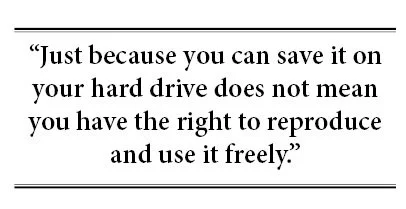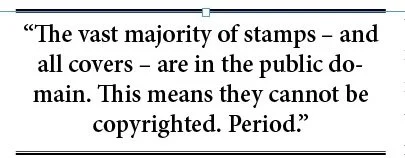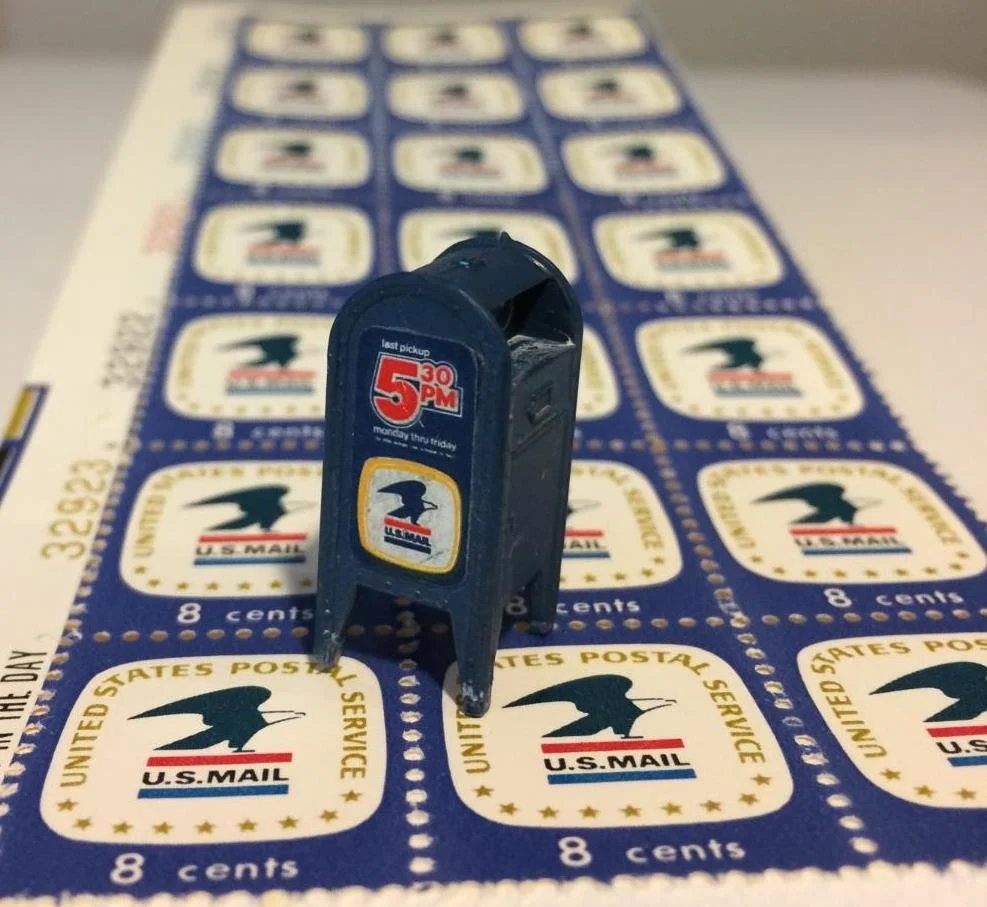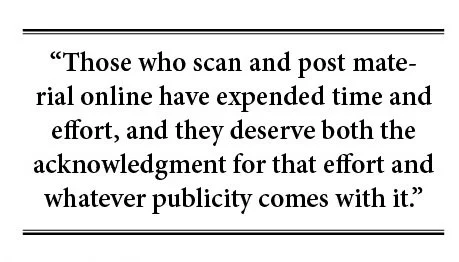A Somewhat Brief Copyright Primer; Responsible, Legal Use of Digital Art
By Wayne L. Youngblood
As a professional philatelic editor and author for more than 35 years, I have been fairly deeply involved with copyright law, as well as numerous violations of it – intentional and non-intentional – and have dealt extensively with various aspects related to both the reproduction of philatelic images and the text of articles. Periodically, I find it useful to publish some general guidelines helpful to all. What follows should be useful to all authors, as well as exhibitors and desktop publishers.
Most collectors and dealers, as well as those involved tangentially with philatelic publishing (newsletter editors and such), frequently have little knowledge of basic copyright law – something that affects us all. While newsletter editors and authors should have at least a grounding in what is protected and what is not, there is no excuse for anyone attempting to be a publishing professional to claim ignorance of the law. Unfortunately, this happens all too frequently. This has been further complicated by the explosion of the availability of readily accessible digital art. Just because you can save it on your hard drive does not mean you have the right to reproduce and use it freely.
I am not a lawyer, and this is not intended as legal advice (and should therefore not be used as your bottom line), but this article should provide you with some good general guidelines for both text and images, with a stronger focus on what is reasonably expected of you when dealing with digital art.
If you have questions regarding a particular situation, you should always consult an attorney with specific experience in copyright law before proceeding with any action about which you are unsure.
Please note the following article addresses only the situation of a philatelic author in its broadest sense to include bloggers, as well as authors of philatelic articles or books. The reproduction of copyrighted text or images for financial gain, or reselling previously published and copyrighted material in books, for example, raises other issues not directly addressed in detail here. But the publication of protected material – in any form – is unacceptable. It’s your responsibility to know what’s acceptable.
Before diving headlong into the specific world of digital and other image reproduction, let’s take a quick look at basic copyright and the public domain, which is an extremely complex subject. Public domain means that a work – literary, musical or illustrative – is no longer protected and may be used freely by anyone, for any purpose, including reproduction for profit.
Each Jan. 1 is, to some of us, Happy Public Domain Day. What this means is that at the beginning of each year, the moving target of expired copyrighted materials moves along a bit. For example, this year Winnie the Pooh (the first book) and poems written by Dorothy Parker in the 1926 Enough Rope entered the public domain, as did some of the works of Ernest Hemmingway, William Faulkner and Franz Kafka, to name a few. On Jan. 1, 2024, unless Disney successfully blocks it, early iterations of Mickey Mouse will enter the public domain as well (including the film Steamboat Willie).
Although there is no “one size fits all” rule of thumb for public domain (and there are exceptions), for those of us in the United States, it's good to remember the following:
1. Works created by those who died in 1951 are now in the public domain (life plus 70 years). On Jan. 1, 2023, public domain will include the works of those who died in 1952.
2. For authors and artists who lived in countries with a “life plus 50 years” provision (such as Canada and New Zealand, as well as much of Africa and Asia), the works of those who died in 1971 are now public domain (1972 as of Jan. 1, 2023).
3. All works published in 1926 or before are now in the public domain. This will include 1927 as of Jan. 1.
4. All sound recordings created before 1923 (1924 as of Jan. 1) are in the public domain.
It should also be noted that newly published works of material in the public domain may be copyrighted if there have been significant editorial enhancements or original illustrative work added (the new “package,” as opposed to the basic work).
Let’s talk about magazines
For those who contribute articles to various philatelic journals and magazines, most reserve the equivalent of First North American Serial Rights, as well as non-exclusive perpetual rights in all media. What this means is that those publishers may reproduce anything they’ve published in print, online or any other media – now or in the future if they wish – but others may not, or at least not without permission. The presentation in each magazine – including all editing and layout – is specifically copyrighted and may not be reproduced in whole or in part in any form without specific written consent of the editor.
However, unless a publication specifies it is purchasing or assuming all rights to your material, those who contribute still own the rights to their own material and may publish or republish it elsewhere if they wish – as long as it is not the specific edited and laid-out version that appeared in whatever journal in which it was published (again, unless permission is granted). In this sense, organizations are protecting not only their work and our interests, but those of their contributors as well.
These guidelines are fairly straightforward and should not present confusion. If you have any questions, it is best to discuss them with the publisher before and article is published.
Zooming in on using philatelic images
Many years ago, there was a well-known stamp-collecting lawyer (not one who specialized in copyright law) who felt – and tried to demand – that any image of any stamp or philatelic item he owned belonged to him, with all rights of reproduction anywhere held by him (he was looking for royalties, as well as a form of personal exclusivity and control). I’ve seen others attempt the same trick in various forms (including U.S. Postal Service staffers who claim all U.S. stamp designs are copyrighted), but neither the law nor practice supports them.
Were this individual’s demands backed by law and justified? In a word, no. While he successfully bullied a few collectors and journals, his demands far exceeded reality and, fortunately, most knowledgeable people recognized this at the time. But not all is free and clear – either in terms of what is required by law or by common courtesy. Thus, it is good to have general guidelines to follow.
It has always been my preference to illustrate columns, articles and features I write with material I own. This is the easiest and most straightforward way to go. For one thing, there is no question of ownership or rights use. However, recognizing that to tell a specific story it’s not always possible to use only self-owned material, I find it occasionally necessary to use other sources of illustrative material. There are many, including friends; research sites, such as the Library of Congress and others; eBay; dealer websites; and numerous other online resources.
Regardless of source, your first responsibility is to assess whether the image you’ve found online is of a high-enough quality for print reproduction (if print is your goal). Many, if not most, are not of suitable quality (that’s a subject for another article). What’s acceptable for an online presentation or programs such as Powerpoint may very well not be reproducible for a print publication. The resolution of these images is just too low; that is, there is not enough information in those digital images for print reproduction.
But how do you deal with a situation when the only available philatelic image is subject to a copyright (whether owned by a postal authority or a private party), or if a copyright or some form of “licensing” is claimed by a website owner? The first thing to assess is the “risk.” Many who claim to own copyrights either for specific stamps or stamp images are mistaken or intentionally overreaching.
First and foremost: The vast majority of stamps – and all covers – are in the public domain. This means they cannot be copyrighted. Period. It doesn’t matter what rights are “claimed”; it is all public domain. A specific presentation of stamps or covers can be copyrighted, however. More about that later.
Stamps. Most stamps of the vast majority of countries are produced by government entities using public funds, so copyright is almost never an issue. That’s the case for all U.S. stamp designs prior to 1978. Again, there is no copyright for any U.S. stamp design prior to 1978 – even if you wish to make and sell tee shirts or other products using them. They are all in the public domain, even though the USPS website claims otherwise.
Even reproduction of those stamp designs that are copyrighted (such as modern United States postage stamps since 1978) are generally covered by “fair use” if you are using them to illustrate an article – certainly if you are picturing an actual stamp, with its unique characteristics. Under Section 107 of the Copyright Act, the fair use doctrine provides that the reproduction of copyrighted material “for purposes such as criticism, comment, news reporting, teaching (including multiple copies for classroom use), scholarship, or research, is not an infringement of copyright.” All other issues aside, most philatelic writing would fall under this category.
Covers. As for covers, they are all simple artifacts of postal processing. As such, these unique pieces cannot be copyrighted unless, for example, they utilize original artwork, such as a protected cachet. Even still, the processed artifact is a unique item.
Rare stamps. For rare stamps and covers (even unique ones, such as the Penny Magenta British Guiana), again, simply owning a postal artifact does not entitle one to either ownership or control of all images or depictions of that item. This was what was unsuccessfully attempted by my lawyer acquaintance in the late 1980s and early 1990s, and it failed miserably by virtually any legal litmus test.
A simple scan of a stamp – any stamp – doesn’t justify copyright protection.
Thus, for philatelic purposes, unless there is some form of original work involved, such as a montage of images or an artist’s original artwork, we are generally free to write about and depict most any item we wish – from virtually any source – regardless of boilerplate warnings and other intimidating scarecrows frequently found on both personal and company websites. Specific permission for publishing reproductions of scanned stamps or covers is not a legal requirement.
That having been said, however, this does not give us free license to ride roughshod over the hard work others have expended in scanning and posting material. Anyone knowingly using material from either private or commercial websites without acknowledging their origin is doing themselves and the hobby a disservice. Those who scan and post material online have expended time and effort, and they deserve both the acknowledgment for that effort and whatever publicity comes with it.
While neither the image of the Inverted Jenny, nor the scan of this particular stamp (position 94) is technically copyrightable, it would be extremely rude, inconsiderate and simply unethical to fail to acknowledge the source of the high-quality image in an article or elsewhere.
Courtesy Robert A. Siegel Auction Galleries.
A great example of this is the Robert A. Siegel auction firm website. The company has gone to a great deal of trouble, expense and effort to provide the extensive resource that it does. The scans are top-rate and the background information is above reproach. To repurpose that company’s scans in any form without acknowledgment would be rude and unethical – to say the least!
If an individual posting simple scans of covers or stamps online truly wishes to “protect” the images they use (that is, prevent reuse by others), it is fully their responsibility to either watermark those images (making them unusable for all practical purposes) or otherwise deface them to discourage use by others. Once again, simple ownership of a philatelic artifact does not entitle one to ownership of any or all depictions of it.
The most important fact to remember, whether dealing with your own or others’ work, is that copyright rewards originality, not effort.
As mentioned previously, stamp images themselves really cannot be copyrighted by anyone other than by the issuing authority, and even then it’s a slippery slope.
Again, in the case of stamps created utilizing any public funds (as is certainly the case with USPS, federal duck stamps and other similar government-issued stamps from other countries), they are – quite simply – forever in the public domain. Even when images can, in theory, be copyrighted, such as U.S. postage stamps released from 1978 to now (1978 is when the “new” USPS, which doesn’t use public funds, began copyrighting stamp designs), a retroactive copyright cannot be claimed – even by the so-called “rightful owner.” That ship has long since sailed.
Now, let’s deal with reproduction (mechanical, electronic or any other media) as it relates to philatelic artifacts: Most items offered on websites, or those appearing on research sites, are simple scans; that is, true reproductions of the original artifact. They are not “derivative” works (an important word we’ll cover shortly).
While there is little question that those who created these images have invested time and effort (the so-called “sweat of the brow” argument), these scans are – in fact – not copyrightable. The “sweat of the brow” concept has long-since been rejected repeatedly by the U.S. Supreme Court (Feist Publications v Rural Telephone Service Company, 1991). The same issue has been visited by other court cases, such as Bridgeman v. Corel (1999) and several others – virtually all of which argue that faithful copies of public domain works do not warrant their own copyrights, regardless of whether they are text or image based. Virtually every legal case that has ensued since has not become more liberal towards the copyrighting of scans. Once again, copyright rewards originality, not effort. Essentially, simple scans do not involve any form of original authorship, which would, perhaps, subject them to protection.
Thus, if you were to set up a still life, for example, of a rare stamp, a lamp or other prop and a potted plant, you would be demonstrating, or “creating,” a form of original work from a non-copyrightable image (the stamp). This is otherwise known as a “derivative work,” and it would probably be subject to copyright protection, although not necessarily. In essence, you have added to – or modified – the item significantly enough to create an “original” work, rather than a simple reproduction.
he stamps shown here are not copyrightable, nor are images of them. However, this particular mini-mail tableau shows enough originality that it could – possibly – be protected under the U.S. Copyright Act.
A scan, on the other hand (regardless of how good), does not reflect any original work related to a non-copyrighted design and is therefore not entitled to any legal protection.
Now, despite this seemingly green light, it is my feeling – again – that it would be ethically (although not legally) wrong for anyone to knowingly garner the fruits of another’s efforts without attribution. A perfect example of this is the aforementioned Siegel website.
If you are contemplating utilizing a scan or other non-original image from a website, it is always important to attribute the source. This is both common sense and a vital courtesy. You may even wish to contact the site’s owner to let them know of your intent, although you may meet resistance from some with this approach. While you may technically be “in the right,” some website owners or managers are very touchy about reproduction, or may be misguided about protection to which they feel entitled. You may or may not wish to push this issue too far.
On the other hand, it has been my experience that many website owners and developers are quite cooperative and will even send high-quality images, if requested, and assured that full attribution will be given. This is not only fair, but appropriate.
As an editor and publisher, I cannot – and will not – attempt to police images used in contributors’ articles. I am neither ethically nor legally responsible for enforcing a common or professional courtesy. Ultimately, you need to decide what is necessary to provide as illustrations, as well as how fully you extend your personal and professional courtesy in obtaining necessary images.
To reiterate a few important points:
1. It is never appropriate, nor legal, to simply appropriate part of an individual’s editorial work (text, editing, layout and more) as it appeared in any publication, unless it is now in the public domain. This type of “borrowing” is not only unethical, in most cases it’s illegal.
2. It is always best to use, for illustration purposes, either material you own or that is clearly intended for restriction-free reproduction.
3. Many online images do not contain enough raw information to be suitable for print publication (low resolution). It is important to find images that will reproduce well in print.
4. Many websites either claim to own a copyright or some form of “licensing” for images of stamps. While copyright protection does apply to a site as an overall creative work, it does not apply to simple scans of stamps or covers found on that site. Still, if you use these images, you should always credit the source as, once again, significant effort has been put into the work of scanning those images. It is both courteous and ethical to give credit where credit is due. The possible exception to this is eBay, as it is individual sellers who have provided images, not eBay. Still, while not necessary, you could mention it’s an eBay scan if you wish.
5. The vast majority of stamp designs are not copyrighted – nor are the stamps themselves copyrightable – and virtually all mailed covers are in the public domain. Copyright rewards originality, not the effort of simply scanning an item.
6. If an owner or author of a website truly wishes to “protect” the images found on it, then it is his or her responsibility to visibly “watermark” or otherwise deface image to discourage reuse.
7. Even if an image is somehow copyrighted, you may be entitled to reproduction in philatelic writing under the “fair use” doctrine of the Copyright Act.
8. It is never appropriate to “borrow” an image from a professional or personal website without proper attribution. While this is not a legal requirement, it is a vital and important personal and professional courtesy.
9. In many cases, the owner of a website may be willing to provide a high-quality image for reproduction if requested and assured that attribution will be given.
I hope this not-so-short refresher course can help all involved with philatelic reproduction achieve a simpler and more rewarding experience in providing interesting content to the hobby.





